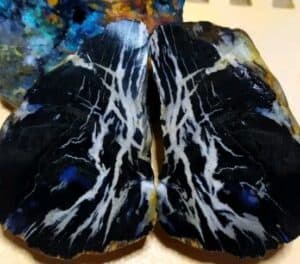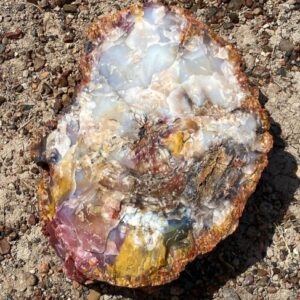Petrified Wood combines the complex patterns of primordial tree rings with a complete spectrum of beautiful shades of browns and dark black earthy tones.
Petrification is a type of fossilization. This means that all Petrified Wood is fossilized, but not all Fossilized Wood is petrified. For a specimen to be considered “petrified,” the original host or organism’s cells must have been replaced by minerals through a process called permineralization so a record of the internal structure is preserved.
Types of Black Petrified Wood
There are several types of Black Petrified Wood. Jet, Black-and-White, Black Opal, and Black Crystalized Wood are excellent examples. Let’s dig in!

Jet Black Petrified Wood
Jet Black Petrified Wood, AKA Jet, is fossilized tree wood. Jet is lightweight and has a hardness of 2.5 on the Mohs Hardness Scale.
This type of Petrified Wood has an amorphous system and is considered a mineraloid. Most people don’t know this but Jet is actually a variety of coal called Lignite. It’s warm to the touch with a dull, waxy black color. However, when polished, it offers a high sheen.
Coal is a sedimentary rock containing fossilized plants. It’s cold to the touch and incredibly brittle. Coal typically has a glassy appearance. One of the ways to tell the difference between Coal and Jet is to perform a streak test. If the specimen produces a brown streak, it’s Jet, whereas a black streak identifies Coal.

Black and White Petrified Wood
Petrified wood entirely charcoal black is rare and requires a trained eye to identify it. When white is present in the piece, it is caused by the presence of Silicon Dioxide, commonly known as free Silica. This occurs in the form of Quartz.

Black Opal Petrified Wood
Wood Opal is a variety of Petrified Wood that has developed an opalescent sheen. We rarely see a variation where the wood is entirely replaced by Opal, but this does occur. Other names for this opalized sheen-like wood are Opalized Petrified Wood and Opalized Wood.

Black Crystalized Petrified Wood
If you’ve ever noticed that some pieces of Petrified Wood are incredibly sparkly, there is an interesting reason for this. Petrified Wood comprises Silicon Dioxide crystals, better known as Quartz. The crystals in Petrified Wood are typically microscopic, creating an appearance similar to opaque Jasper stones. Sometimes, a hole was present in the wood before it got buried, and inside the holes, larger Quartz crystals form. This process creates a beautiful array of druzy Quartz.

Black Hills Petrified Wood
South Dakota’s Petrified Forest of the Black Hills is home to a museum that’s been open since the late 1920s. The forest is near Rapid City, and the Earth naturally preserved a Cypress swamp that’s over 120 million years old. During the time of the dinosaurs, the entire area was a flat, tropical swamp.
The Cypress trees that fell in this area centuries ago became immersed in water; over time, sand and silt permeated the wood, transforming it into stone. The swamp began receding, causing the logs to become buried deeper, preserving their stone state.
Eventually, Earth began transforming the land. The Black Hills were pushed up, causing the swamp to rise. The buried petrified logs broke as they were displaced as if someone cut them into logs. When the elements finally wore away the protective layers of sand, they were eventually discovered.

Black Forest Petrified Wood
In the north section of the Petrified Forest National Park in Arizona, we can find the Black Forest. The logs in this region are darker in color. There are many complete tree trunks at a length of 50 feet or more, spread across multi-hued badlands split by plateaus and ravines.
The National Park is a National Monument, so we cannot collect petrified wood from this area. However, rockhounds and enthusiasts were collecting Petrified Wood from the Black Forest many years before it was prohibited. That said, Black Forest Petrified Wood can be pricey.
Is Black Petrified Wood Rare?
It’s rare to find a piece of entirely black Petrified Wood, but black hues and tones are common colors in the wood. Most Petrified Wood features a bit of black. That’s because when carbon gets mixed into the water where the wood is immersed, it creates black colors naturally.
How Much Is Black Petrified Wood Worth?
Petrified wood costs between twenty-five cents and two dollars per pound. The quality, rarity, size, and condition of a specimen impact pricing. One might expect to see rare pieces of high value for as much as 10 bucks a pound, or more, depending on the market.
Buy Petrified Wood
Petrified Wood can be purchased at gem and mineral shows. Fossil shops are excellent places to get quality pieces. Of course, there are many private sellers as well.
When purchasing a rare specimen like the Black Forest Petrified specimens, get any records or documentation. This will help with any future sales and for personal records.
- Identify Enstatite - March 12, 2024
- Identify Cerussite - March 3, 2024
- Identify Bytownite - February 18, 2024

6 Responses
Hello
I found a piece i thought
Was black tourmaline but not so sure.Are the two easily confused if not what do i look for..i found
It among limestone geods
Dolomite n Micrite ,Mudstone in WV.
Stephen – The texture of the black tourmaline could be a strong tell. Does it have faceted top? Black tourmaline will have a 3-4 facet point at the top if its not broken. Black tourmaline will have a porous or grainy looking internals. Hope that helps and feel free to use the contact us page and send me your contact details. I’ll reply and you can send a couple of photos.
Hi, interesting article. We have a huge collection of black petrified wood found in Warwickshire, UK. Looks much like the crystallised wood photo you have.
We believe it to have been deposited by glacial action possibly related to the Avon terraces here in Warwickshire. We are not sure of the exact age and what type of wood it is but it is in plentiful supply throughout a lot of fields near to us!
Simon – I appreciate you sharing and I’m going to email you directly for some photos.
Found Black petrified wood in a hard gray clay. Gold pyrite and iron pyrite found with it
David – Solid find! Where about did you find it?